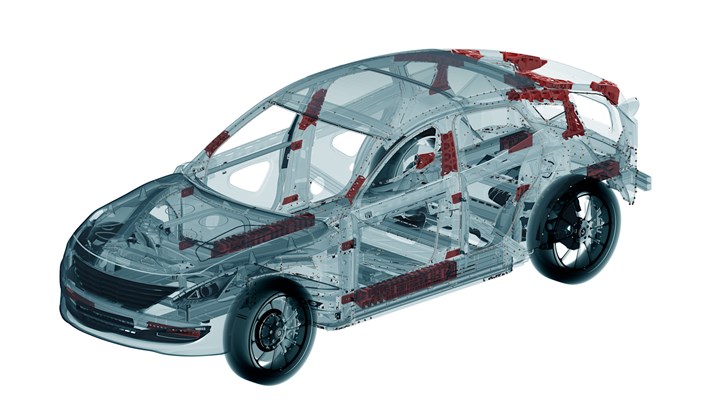Next-Generation Adhesives Provide New Opportunities
Where adhesives are concerned, automotive applications are proving to have real staying power. From helping meet lightweighting challenges to effectively addressing the ever-increasing electronics requirements, adhesives are a full-spectrum solution worth investigating.
#electronics

Performance-improvement opportunities for adhesives are replete throughout vehicle design. (Image courtesy The Mobility Alliance)
“It’s an exciting time for adhesive technologies,” remarks Mark Zahradnik, head of commercial engineering – Americas for Henkel Corporation (www.henkel-adhesives.com/us). Interest in adhesives covers joining dissimilar and non-traditional automotive materials where mechanical methods can be limited in application or performance. Also, structural adhesives can help streamline assembly processes, contribute to lightweighting, and improve vehicle crashworthiness.
Recent market research is indicating the global automotive adhesives market – covering epoxies, acrylics, polyurethanes, and silicones – is projected to reach $10.7 billion by 2024 at a compound annual growth rate of 5.7% during the period. Research also targets the Asia Pacific region as a hot spot of rising demand, citing per-capita-income improvement in China, India, South Korea, and Thailand, as part of the reasons why.
While automakers continue using high-strength, lighter-weight steels, newer low-density metals, including aluminum and magnesium grades, are increasing in demand, as are polymer materials such as fiber-reinforced composites. “Modern, lightweight designs require new bonding technologies to optimize the materials mix incorporated in today’s vehicle structures,” says Syed Mahdi, scientific principal for Henkel product development. “Bonding is of special importance because it enables combinations of new materials while providing structural advantages that enhance the integrity of the vehicle body-in-white.”
That doesn’t make it easy. Challenges range from achieving bonding without the need for surface preparation to managing thermal expansion mismatch situations. “A fundamental understanding of substrates, adhesives, and plant-processing parameters is needed to ensure optimal conditions for bonding assemblies, especially in the case of mixed materials. Lightweighting requires a high degree of collaboration and consideration to the entire vehicle development process,” Mahdi explains.
Industry Alliance
To further develop engineered solutions for automotive adhesives and sealants, Henkel recently announced a partnership with Germany-based engineering firm RLE International, called the “Mobility Alliance.” “It combines Henkel’s material science knowledge with predictive analysis, modeling, and simulation in the areas of full-vehicle crash behavior, lightweight design concepts, as well as battery integration and protection,” Zahradnik says.
The pilot project of the Mobility Alliance evaluated the potential for lightweight and safety concepts including the downgauging of the A-pillar/B-pillar reinforcements on an e-SUV while maintaining the roof-crush performance standards of the Insurance Institute of Highway Safety (IIHS). Henkel’s structural solutions were used in targeted locations on the A- and B-pillars, as well as other areas to create a hybrid solution that reduced body-in-white (BIW weight) while exceeding IIHS standards.

Adhesives can also protect against environmental intrusion–filling voids and gaps for connectors, sensors, ECU modules, water pumps, inverters, converters and battery packs. (Image courtesy Henkel)
Henkel’s hybrid structural solution consists of two material components made of reinforced polyamide and lightweight, high-performing structural foam from its TEROSON EP family of products. Overall, the pilot program achieved a significant overall weight savings of 42 kg (92.5 lb). These results demonstrate the importance of providing lightweighting and bonding solutions at the early stages of vehicle design and development, given that these material gains were achieved at the BIW stage.
Crash protection is especially crucial for battery electric vehicles because of the inherent risk to battery and hybrid electrical systems. “Structural adhesives help automakers meet stringent crash standards by improving the stiffness of car body assemblies, with up to a 25 percent increase in absorption in metal structures compared with traditional rivets or welds,” Zahradnik adds.
Vehicle Electronics
The value of chemical adhesive solutions extends far beyond the architecture of battery electric vehicles (BEVs) and impact entire vehicle electronic systems – predicted to approach 50 percent of a car’s value by 2030. Applications include electronic control units, sensors, cameras, connectors, displays, wire harnesses, and more. Chemical solutions ensure that in-vehicle electronic systems and overall vehicle electronics stay in place and deliver performance and safety functions. Structural and liquid adhesives must address and protect against mechanical shock, electromagnetic interference, environmental influences and other factors that can degrade electronic functionality and reduce longevity. In addition, thermal interface materials are essential to keep BEV battery packs from overheating
While thermal interface materials work to keep temperature in check, liquid sealing solutions provide design flexibility while protecting against environmental intrusion – filling voids and gaps for connectors, sensors, ECU modules, water pumps, inverters, converters and battery packs. In addition to enabling a reduction in weight, adhesive materials help maintain fastener tension, distribute stress evenly, and provide excellent chemical resistance.
Adhesive developments now and in the future naturally depend on close relationships with designers and engineering departments of global automotive OEMs. Early engagement in vehicle development helps ensure optimal use of adhesives, meeting future vehicle requirements for design flexibility, improved performance, and of course, cost efficiency.
RELATED CONTENT
-
On Military Trucks, Euro Car Sales, Mazda Drops and More
Did you know Mack is making military dump trucks from commercial vehicles or that Ford tied with Daimler in Euro vehicle sales or the Mazda6 is soon to be a thing of the past or Alexa can be more readily integrated or about Honda’s new EV strategy? All that and more are found here.
-
FCA Opens the Door to The Future
FCA introduced a high-tech concept vehicle today, the Chrysler Portal, at the event previously known as the “Consumer Electronics Show,” now simply CES.
-
On the Genesis GV80, Acura MDX, BMW iDrive and more
From Genesis to Lamborghini, from Bosch to Acura: new automotive developments.

